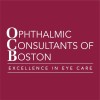
Intravitreal Conbercept Injection in Patients With Myopic Choroidal Neovascularization
Myopic Choroidal NeovascularisationChoroidal neovascularization (CNV) secondary to pathologic myopia (PM-CNV) is a common vision-threatening complication and often affects adults of working age. Intravitreal injection of any anti-vascular endothelial growth factor (VEGF) drugs would significantly suppress the activity of the CNV and finally improve the visual acuity. However, more than half of the patients would need one or more further injection for the recurrence or uncontrolled with 1+pro re nata (PRN) treatment within one year, and whether increasing the initial loading of intravitreal injection of anti-VEGF would be more efficacy for the controlling the PM-CNV remained unknown.

Initial Treatment With Bevacizumab in Choroidal Neovascularization Associated to High Myopia
Choroidal Subfoveal/Juxtafoveal Neovascularization in High MyopiaThe purpose of this protocol is to determine wether the initial protocol in the treatment of subfoveal choroidal neovascularization associated to High Myopia with bevacizumab intravitreal injections is more effective when using 3 doses vs using 1 single dose in the load period

Ranibizumab to Treat Choroidal Neovascularization (CNV) in Patients With Pseudoxanthoma Elasticum...
Choroidal NeovascularizationThe purpose of the study is to investigate the efficacy of a new drug called ranibizumab in the treatment of choroidal neovascularization in underlying angioid streaks due to Pseudoxanthoma elasticum. 10 patients will receive monthly injections of the drug in one eye over a period of one year.

Safety and Efficacy of a New Treatment as Adjunctive Therapy to Anti-vascular Endothelial Growth...
Choroidal NeovascularizationAge-Related MaculopathyThe study will evaluate the safety and efficacy of the intravitreal implant of dexamethasone with Anti-VEGF treatment vs. Anti-VEGF alone (with sham dexamethasone injection) in patients with subfoveal choroidal neovascularization secondary to age-related macular degeneration.

Safety Study of Ranibizumab Eye Injections to Treat Choroidal Neovascularization That Was Caused...
Choroidal NeovascularizationThe purpose of this study is to determine whether ranibizumab is effective in the treatment of choroidal neovascularization secondary to causes other then wet macular-degeneration.

Study Comparing Ranibizumab Monotherapy With Combined Verteporfin Therapy in Subfoveal CNV
Choroidal NeovascularizationAge-Related Macular DegenerationThis pilot study is designed to evaluate the safety and efficacy of intravitreal ranibizumab used in combination with verteporfin photodynamic therapy (Visudyne®) compared to ranibizumab monotherapy for the treatment of subfoveal CNV secondary to AMD

Reduced Fluence Photodynamic Therapy (PDT) With Visudyne in Combination With Lucentis for Age-Related...
Age-Related MaculopathyChoroidal NeovascularizationIn this pilot study the researchers will evaluate the safety and efficacy of 50% reduced fluence PDT combination therapy with ranibizumab. The researchers hope to gain information regarding the use of reduced fluence PDT combination therapy. The information gained from this pilot study may prompt further definitive studies comparing the safety and efficacy of both standard fluence PDT combination therapy, reduced fluence PDT combination therapy, and ranibizumab monotherapy. The study will compare the use of combination therapy with ranibizumab and verteporfin PDT to ranibizumab alone in patients with exudative age-related macular degeneration (AMD). All patients will receive three consecutive monthly treatments with ranibizumab. Patients will be randomized 1:1:1 to 3 groups. Patients randomized to group 1 will receive only ranibizumab. Patients randomized to group 2 will also receive one treatment with reduced fluence (50% fluence) verteporfin PDT at day 0. Patients randomized to group 3 will also receive one treatment with standard fluence verteporfin PDT. All patients will also be evaluated for possible retreatment with ranibizumab and verteporfin PDT according to established criteria. Thirty patients will be recruited from one U.S. sites. Randomization will occur at the time of entry into the study. Follow-up will continue until month 12 (from day 0) in all subjects.

Reduced Fluence Visudyne-Anti-VEGF-Dexamethasone In Combination for AMD Lesions (RADICAL)
Choroidal NeovascularizationMacular DegenerationThe objective of this study is to determine if combination therapy (reduced-fluence Visudyne followed by Lucentis [within 2 hours] or either of two regimens of reduced-fluence Visudyne followed by Lucentis-Dexamethasone triple therapy [within 2 hours]) reduces retreatment rates compared with Lucentis monotherapy while maintaining similar vision outcomes and an acceptable safety profile.

Efficacy and Safety of Ranibizumab in Patients With Subfoveal Choroidal Neovascularization (CNV)...
Age Related Macular DegenerationThe study will test if the efficacy and safety of an alternative dosing regimen is as effective as monthly injections.

Ranibizumab in Hemorrhagic Choroidal Neovascularization Trial
Choroidal NeovascularizationThis research is being done to look at the effects of an experimental drug, ranibizumab, on a condition called "predominantly hemorrhagic subfoveal choroidal neovascularization (CNV)" due to wet age-related macular degeneration. A predominantly hemorrhagic CNV lesion is diagnosed when at least 50% of the choroidal neovascular lesion is occupied by blood under the retina. We want to find out if injections of ranibizumab into the eye will help patients with this condition.
